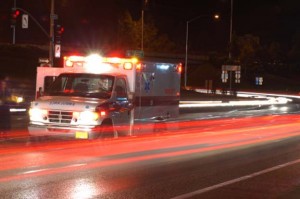Traffic fatalities fell to their lowest level in more than six decades last year, according to a new analysis by federal regulators, continuing a decade-long decline – though there are some preliminary signs that the death rate may have turned back upward in 2012.
The ongoing decline appears to show the benefits of the latest advanced safety technology, like electronic stability control – some of which can “compensate for poor judgment” — as well as increased usage of simpler, time-tested devices such as seatbelts. Experts also give credit to increased enforcement, especially the crackdown on drunk driving. Yet another factor, though, may also be the medical knowledge gained from two long wars.
“The latest numbers show how the tireless work of our safety agencies and partners, coupled with significant advances in technology and continued public education, can really make a difference on our roadways,” says U.S. Transportation Secretary Ray LaHood. “As we look to the future, it will be more important than ever to build on this progress by continuing to tackle head-on issues like seat belt use, drunk driving, and driver distraction.”
According to the National Highway Traffic Safety Administration, highway deaths dipped to 32,367 during 2011. That was down 1.9% from the previous year and comes in as the lowest number since 1949. The fatality rate averaged 1.10 deaths per-100-million-miles-driven , the lowest figure ever seen during nearly a century of government record-keeping.
A variety of factors appear to have contributed to the sharp decline, but analysts and observers give much of the credit to the increasing use of advanced technology. “We’ve added a tremendous of safety gear, like side-impact airbags and stability control which can help compensate for poor judgment and driver error” to prevent crashes, says David Sullivan, of the consulting firm AutoPacific, Inc.
According to a study released two weeks ago by NHTSA, electronic stability control, also known as ESC or ESP, has saved an estimated 2,200 lives over the past three years – and the rate is expected to continue to grow as the technology is more widely used – after being mandated for all U.S. passenger vehicles starting on September 1, 2011.
(For more on that story, Click Here.)
Such technology, along with better-designed vehicles using advanced, high-strength steels and other material, also can improve the likelihood of surviving a crash that might have been fatal in decades past.
There are other factors saving the lives of those who have been seriously injured, adds Dr. David Cole, director-emeritus of the Center for Automotive Research, in Ann Arbor, Michigan. He points to the fact that most Americans carry cellphones today. It means authorities are likely to be notified of a potential crash within moments, today.
“And our emergency responders have learned a lot about dealing with trauma from what has happened in the two wars we’ve been fighting,” Cole points out. Methods developed to develop with blunt force traumas like improvised explosive devices, in particular, can be put to use following a major crash.
But there are low-tech factors also at work. Just a month ago, NHTSA revealed that seatbelt usage has reached a record high, at 86%, the agency estimating that 220 lives are saved annually for every percentage point belt usage rises.
When it comes to driving safely, one of the most effective ways to protect yourself and your family is to use a seat belt,” DoT Sec. LaHood said last month.
(For more on the increase in seatbelt usage, Click Here.)
Law enforcement, meanwhile, has also played a significant role in a steady decline in highway deaths that began in 2005 when 43,510 fatalities were reported. In particular, NHTSA reports that deaths in crashes involving drunk driving fell by 2.5% in 2011, though it was still blamed for the loss of 9,878 lives.
If anything, there’s concern that another issue could result in rising fatalities – the increase in texting and other driver distractions, something Sec. LaHood has cited as his biggest concern. A growing number of states have passed laws restricting the use of handheld phones and barring texting by a driver but evidence suggests enforcement has so far been spotty, at best.
That may play a role in some preliminary data that found a slight rise in the total number of highway deaths during the first months of 2012. That increase may also reflect the fact that Americans are driving more as the country emerges from its long recession.
Meanwhile, pedestrian fatalities have also shown a trend upwards. A total of 4,280 pedestrians were killed in vehicle-related incidents in 2010, according to NHTSA, another 70,000 injured. In 2010, pedestrian deaths accounted for 13% of all traffic fatalities. That compared with 11% between 2002 and 2007 – though the percentages are skewed by the continuing decline in deaths among motor vehicle passengers.
Experts warn that distracted driving may be one of the factors behind the rise in pedestrian deaths.
(For more on the rise in pedestrian fatalities, Click Here.)

